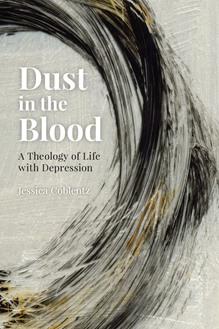
"Hagar in the Wilderness," 1835, by Camille Corot (The Metropolitan Museum of Art/Rogers Fund, 1938)
Completing this review has been a difficult task. My own depression prevented me from moving ahead, first with reading, despite my great desire to do so, and then writing. Do not assume this means a negative assessment will follow. My time spent with Dust in the Blood: A Theology of Life with Depression by Jessica Coblentz was a powerful experience, although like life with depression, it was difficult. It is no reason to shy away.

I grew up with the belief that depression was "just in your head," and could be wished or prayed away. As a result, my own depression was something to be hidden, not to mention something to be ashamed of. If anything, it seemed like a sin, something that I could or would be judged for having. At this point in my life, I see it differently. This includes not only my own depression, but how I choose to walk with others such as family, friends or those I encounter in a pastoral care relationship. That is why news of Dust in the Blood made me want to explore its contents.
The topic of suffering before God is foundational to a life of faith, and this premise is important to the role of depression in life through a theological lens. The book begins with some of the familiar theologies of depression such as moral evil, a "dark night" and spiritual warfare.
In a chapter entitled "How (Not) to Talk about Depression," the author forges a path that accomplishes a rich portion of this book, beginning with the question "How should Christians talk about depression?" Regrettably there is a great deal of misconception regarding depression at large, and in Christian life, potentially more so. This chapter is almost the midpoint of the book, but its premise and its conclusions are vital to her study. The misuse, misunderstanding, and mistaken beliefs about how and why we suffer can drive many people from their Christianity and keep non-Christians away. Ultimately, each person's own suffering and theological understanding are subjective, but Coblentz offers a lens through which we may see a broader horizon of depression and distress.
The book is divided into two sections, the first being about the landscape and the second about new maps for going forward.
Regrettably there is a great deal of misconception regarding depression at large, and in Christian life, potentially more so.
The exploration of depression as a wilderness experience was exceptionally robust. Biblical stories and landscapes are rife with wilderness experiences that can relate to depression, particularly in arid desert settings. Reminding us of landless or homeless people of God, the wanderings of God's people also fit into this motif. Owning homes, having land, even our rented spaces typically afford us a level of comfort and security. Being cast out is another story and this relationship between an unrooted life and depression is made clear. The Israelites in the desert, the Babylonian exile, Jonah inside the whale, Joseph in the cistern and then Egypt, there are so many examples of life undone by a change in circumstances. These moments can drain us of life force and the journey back, made clinically and in faith, is not always easy.
There is an entire chapter devoted to "Depression as a Hagaric Wilderness" that was particularly pointed. The image of a sculpture of Hagar by Albert Toft graces the page before the chapter begins. Coblentz writes about it, in part saying: "… she kneels naked, her vulnerability apparent. Her raised arms clutch her head in distress. Her closed eyes and arched body evince a consuming interior life that has collapsed her attention inward."
Advertisement
With creative insights and sharp theological instincts, the author analyzes Hagar's powerful story of becoming a mother, then running away, returning and ultimately being cast out. In a dualistic world, we could see Sarah as winner and Hagar as loser, but this story demands we extend our view of God's mercy across boundaries we might not imagine crossed. The promise of God and of goodness beyond the horrific is there. Yet, we are also reminded that Hagar's suffering, not unlike our own at times, offers no real theological "reasons" or purposes. Our desire to experience the comfort of "if this, then that" logic is not possible, and this may be one of the more essential points to this chapter.
By the end of the book, we find ourselves back in the presence of the author and how the title came to be. Driving along a wintry highway, listening to NPR's "Fresh Air" as psychologist Kay Redfield Jamison talked to host Terry Gross about the poet Robert Lowell, Coblentz hears the phrase, "dust in the blood." This moment, an epiphany of sorts, is personal and powerful. Finding familiar scenes from her life both exterior and interior, a moment of clarity breaks through. This ties together the themes we have read about throughout, with the ongoing reminder of God's presence, even in the places where God seems most absent.
This is indeed a scholarly volume that consistently plumbs the depths of academic research and writing. At the same time, it offers an enriching read for a much wider audience. Using her life experience and theological formation, Coblentz combines her personal journey with her faith, her psychological and theological research, and delivers a remarkable volume.
Make no mistake, you will find references and footnotes throughout, but do not let that deter you. The consistent thread weaving it all together is the voice of a human being. As such, her gift is to find fresh ways to discover depression as a matter of faith and theology. With tremendous insight, power and skill, an important publication has been born.








